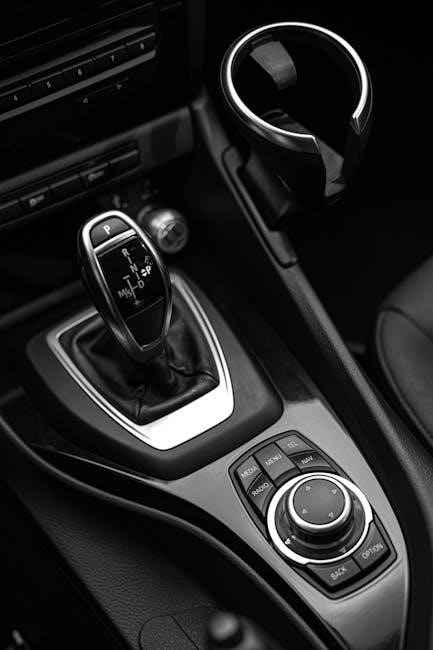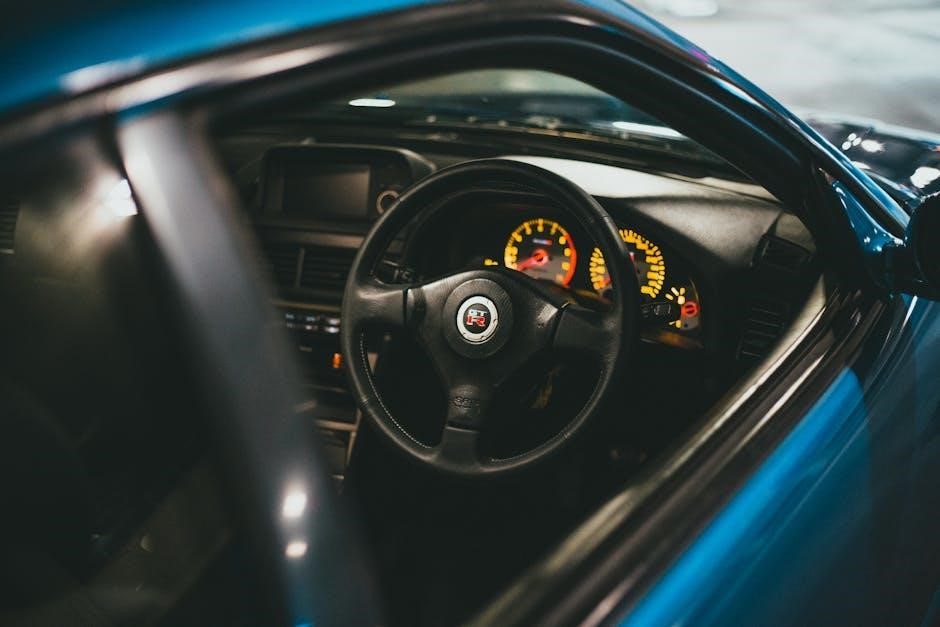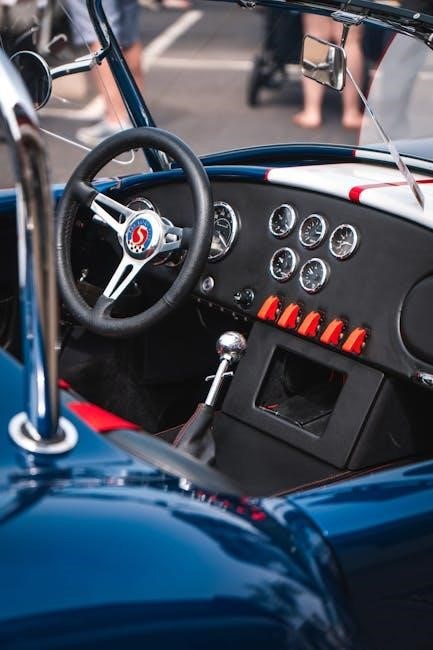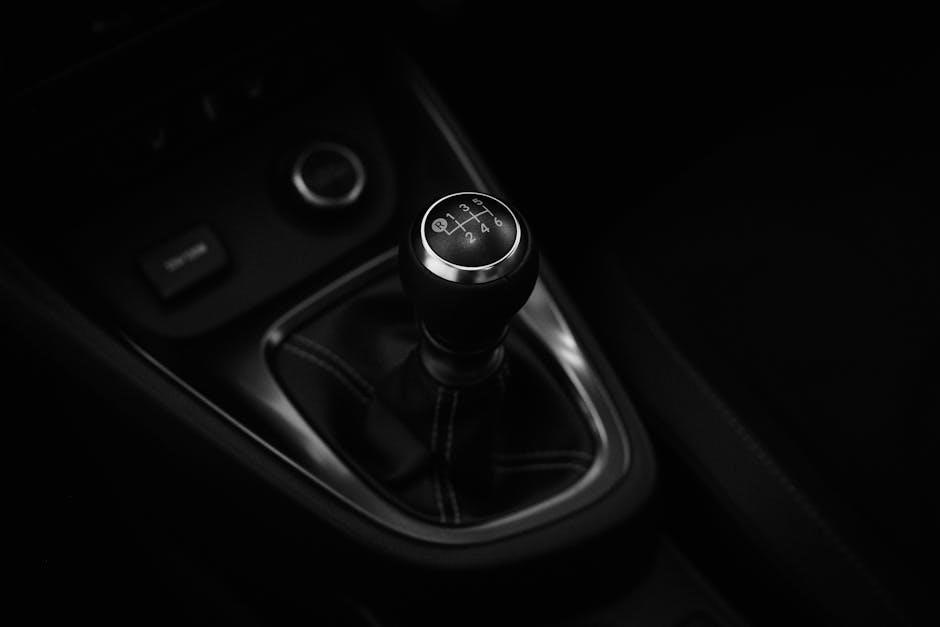Understanding the Basics of Manual Transmission
What is a Manual Transmission?
A manual transmission, or stick shift, is a gearbox requiring driver input to change gears, using a clutch pedal and gearshift for control.
Key Components of a Manual Car
Manual cars feature a clutch pedal, gearshift, and five or six forward gears, enabling precise control over speed and torque.
Why Learn to Drive a Stick Shift?
Mastering manual driving enhances control, fuel efficiency, and driving skills, offering a deeper connection to the vehicle and road.
A manual transmission, also known as a stick shift, is a type of gearbox that requires the driver to manually change gears using a clutch pedal and gearshift. This system provides precise control over the vehicle’s speed and torque, allowing drivers to engage specific gears based on driving conditions. Unlike automatic transmissions, manual transmissions rely on the driver’s input to operate, making them a popular choice for those seeking a more engaging driving experience.
A manual car features a clutch pedal, gearshift, and a set of gears that enable precise control over the vehicle. The clutch pedal disengages the engine from the transmission, allowing smooth gear changes. The gearshift, typically located between the driver and passenger, is used to select the appropriate gear. Manual transmissions usually include five or six forward gears and a reverse gear. These components work together to provide drivers with direct control over speed and torque, making manual cars popular for their engaging and responsive driving experience.
Learning to drive a stick shift offers enhanced control over the vehicle, making the driving experience more engaging and enjoyable. It improves fuel efficiency, which can lead to cost savings on gas. Additionally, mastering a manual transmission can make you a more attentive and coordinated driver. It also provides the ability to drive a wider range of vehicles, including many sports cars that only come in manual. The skill can be useful when renting cars in foreign countries where manuals are more common. Overall, driving a stick shift connects you more deeply with the road, enhancing the driving experience.

Preparing for Manual Driving Lessons
Find a qualified instructor and choose a suitable vehicle for practice. Ensure safety precautions are in place and practice in a controlled environment to build confidence.
Finding a Qualified Driving Instructor
Enroll in a reputable driving school offering manual transmission lessons. Look for instructors with extensive experience in teaching stick shift driving. A qualified instructor will provide personalized feedback, ensuring you master clutch control and smooth shifting. Research schools like Chadrics Driving School or Mini’s manual driving program, known for expert guidance. Instructors should be patient, knowledgeable, and skilled in breaking down complex techniques. Read reviews and ask for referrals to find the best fit. Many instructors also offer refresher courses for those needing to regain confidence. Professional instruction is key to learning efficiently and safely.
Choosing the Right Vehicle for Practice
Selecting the right car for manual transmission practice is crucial. Opt for a compact, lightweight vehicle with a standard 5- or 6-speed gearbox. Cars like the Honda Civic or Toyota Corolla are ideal due to their ease of handling and smooth clutch engagement. Avoid high-performance or heavily modified vehicles, as they can be challenging for beginners. Ensure the car has good visibility and is in good mechanical condition. Many driving schools, such as Chadrics Driving School, provide suitable vehicles for practice. A well-suited car will make learning easier and reduce the risk of stalling or damage. Practice in a safe, open area.
Safety Precautions for Beginners
Ensure all passengers wear seatbelts and adjust mirrors and seats for comfort. Practice in a safe, open area free from traffic. Avoid distractions like phones. Start with the parking brake engaged and shift into first gear before releasing the clutch. Practice feathering the clutch to avoid sudden jerks. Stay calm and avoid rushing. Keep both hands on the wheel when shifting. Use the parking brake on inclines to prevent rolling. Be mindful of surrounding vehicles and pedestrians. Maintain a safe distance and speed. Learning in a controlled environment with a qualified instructor reduces risks and helps build confidence.

Mastering the Fundamentals of Stick Shift Driving
Mastering stick shift driving requires coordination and practice. Focus on smooth clutch engagement, precise gear shifting, and maintaining rhythm to avoid stalling and ensure seamless control.
Getting Familiar with the Clutch and Gearshift
The clutch and gearshift are the primary controls in a manual car. The clutch pedal, located on the far left, disengages the engine from the transmission, allowing smooth gear changes. The gearshift, typically in the center console, selects the desired gear. Start by familiarizing yourself with the clutch’s resistance, known as the “biting point,” where it begins to engage. Practice pressing the clutch fully and shifting through gears with the gearshift, ensuring it clicks into place. Understanding their operation is crucial for seamless shifting and control. Regular practice helps build muscle memory and confidence in handling these essential components effectively.

Starting and Stopping Smoothly
Starting and stopping smoothly in a manual car requires coordination between the clutch and accelerator. Press the clutch fully, shift into first gear, and slowly release the clutch while pressing the accelerator. Avoid sudden movements to prevent stalling. When stopping, downshift to lower gears before coming to a complete stop to maintain control. Feathering the clutch—releasing it gradually—helps prevent jerking. Practice these steps consistently to master smooth starts and stops, ensuring a seamless transition from stationary to moving and vice versa. This skill is foundational for confident and efficient manual driving.

Shifting Gears: A Step-by-Step Guide
Shifting gears in a manual car involves coordination between the clutch, gearshift, and accelerator. Press the clutch fully, move the gearshift to the desired gear, and release the clutch gradually while accelerating. Always match the gear to your speed and RPMs. For smooth transitions, listen to engine RPMs to determine when to shift. When downshifting, use the clutch to match the lower gear to your speed. Practice shifting at different speeds to build muscle memory. Avoid riding the clutch, as it can wear out the components. Smooth, deliberate shifts ensure better control and a more enjoyable driving experience.
Reversing in a Manual Car
Reversing a manual car requires careful coordination of clutch and gearshift. Start by fully pressing the clutch and shifting into reverse gear. Slowly release the clutch while gently pressing the accelerator. Keep movements smooth to avoid jerking. Always check mirrors and blind spots before reversing. Use reference points on the car to gauge distance. Avoid reversing in high gears, as it can cause stalling. Feather the clutch to maintain control, and listen to engine RPMs to ensure smooth transitions. Practice reversing in open spaces to build confidence and precision. Remember, reversing in a manual car demands patience and attention to your surroundings for safe maneuvering.
Common Challenges for Beginners
Beginners often struggle with stalling the car, especially when starting from a standstill. Coordinating the clutch and accelerator pedals can feel awkward at first. Many new drivers find it difficult to shift gears smoothly, leading to jerky movements. Another challenge is mastering the timing of when to press the clutch and when to shift gears, particularly when stopping or accelerating uphill. Additionally, some learners may struggle with finding the correct gear for the vehicle’s speed, causing hesitation or lurching. Overcoming these challenges requires patience, consistent practice, and a focus on developing muscle memory for smooth transitions.

Advanced Techniques for Smooth Driving
Mastering smooth acceleration and shifting enhances control, while heel-toe downshifting and rev matching ensure seamless gearchanges, reducing wear and improving performance.
Mastering Smooth Acceleration and Shifting
Smooth acceleration and shifting require precise coordination between the clutch and accelerator. Listen to engine rpms to determine optimal shift points, ensuring seamless transitions. Practice feathering the clutch for gradual acceleration, especially uphill or in heavy traffic. Use rev matching during downshifts to maintain control and reduce wear on the transmission. Smooth shifting enhances fuel efficiency, reduces jerking, and improves overall driving comfort. Regular practice in varied conditions, such as inclines and city driving, helps refine these skills. Advanced techniques like heel-toe shifting can further polish your driving style, making every gearchange fluid and precise.
Heel-Toe Downshifting: A Pro Technique
Heel-toe downshifting is an advanced method used to maintain speed through corners. By pressing the brake with the toe and blipping the throttle with the heel, drivers match engine speed to the lower gear, preventing wheel lockup. This technique, often used in racing, ensures smoother gearchanges and better control. Practice heel-toe in low-speed maneuvers to build muscle memory. Proper footwear and pedal placement are crucial for effective execution. Mastering this skill enhances driving precision and reduces wear on braking components, making it a valuable technique for both everyday driving and high-performance situations.
Rev Matching for Seamless Gearchanges
Rev matching is a technique used to align engine RPM with the intended gear during downshifting, ensuring smooth transitions. As you downshift, press the clutch, select the lower gear, and briefly “blip” the throttle to match engine speed. This prevents jolts and wear on the drivetrain. Rev matching is particularly useful in performance driving or when braking before corners. It enhances control and reduces clutch strain. While not essential for everyday driving, mastering rev matching elevates your driving precision and makes gearchanges feel more polished and deliberate.
Hill Starts: A Critical Skill to Master
Hill starts are a challenging but essential skill for manual drivers. To master them, find a safe, inclined surface to practice. Engage the parking brake and press the clutch while in neutral. Shift into first gear, release the clutch slowly, and press the accelerator gently. If the car rolls back, feather the clutch and brake simultaneously. Practice uphill and downhill starts to build confidence. Start with gentle slopes and gradually increase difficulty. Smooth acceleration and precise clutch control are key to avoiding stalling or rolling. Regular practice will refine your technique and improve overall manual driving proficiency.

Practice Strategies for Success
Find a safe, open location to practice, starting with flat surfaces and progressing to hills. Use simulators or online tools to refine skills and build confidence.

Finding the Best Location to Practice
Identify a safe, open space like an empty parking lot or quiet street to practice manual driving. Avoid busy areas to minimize stress and distractions. Begin on flat surfaces to master basic techniques before progressing to hills. Use online simulators or apps to supplement real-world practice and refine your skills. Consider enrolling in driving lessons with a qualified instructor for personalized feedback. Practice during off-peak hours to ensure ample space and reduce pressure. Consistency is key; dedicate regular time to improve your proficiency in controlling the vehicle smoothly.
Practicing Uphill and Downhill Driving
Mastering uphill and downhill driving in a manual car requires precision and control. Always use a lower gear when ascending steep hills to maintain traction and avoid rolling backward. When descending, downshift to control speed without excessive braking. Practice feathering the clutch uphill to prevent stalling and maintain momentum. For descents, use the correct gear to keep the car at a steady pace. Find a safe, secluded area with varying inclines to practice these techniques. Focus on smooth transitions between gears and maintain a steady throttle. These exercises build confidence and refine your ability to handle diverse terrain effectively.
Mastering Night Driving in a Manual Car
Night driving in a manual car requires heightened awareness and smooth control. Use low beams to avoid blinding others and maintain a safe distance. Shift gears smoothly to avoid jerky movements, especially when braking or accelerating. Keep the clutch and accelerator transitions gentle to maintain visibility and control. Practice in well-lit areas first to build confidence. Always be mindful of your surroundings, as reduced visibility demands extra caution. Mastering night driving enhances your overall skill and safety, ensuring you can handle any situation confidently behind the wheel.
Using Simulators or Online Tools for Practice
Simulators and online tools offer a convenient way to practice manual driving skills. Many driving schools provide virtual platforms that mimic real-world scenarios, allowing learners to master gear shifting, clutch control, and braking in a risk-free environment. Interactive tutorials and video guides demonstrate proper techniques, while virtual lessons cover essential maneuvers like starting, stopping, and reversing. Some tools even include progress tracking to help users improve. These resources are particularly useful for beginners who want to build confidence before practicing in an actual car. They complement traditional lessons and accelerate the learning process for mastering manual transmission driving.

The Benefits of Learning to Drive a Manual

Learning to drive a manual enhances control, improves fuel efficiency, and connects you deeply with the driving experience, boosting overall skills and confidence behind the wheel.
Improved Control Over the Vehicle
Manual transmissions grant drivers unparalleled control by allowing precise gear selection and power delivery. Using the clutch and gearshift, you can adjust speed and torque to match driving conditions. This connection fosters a deeper understanding of the vehicle’s mechanics, enabling smoother acceleration and deceleration. Expert instructors emphasize that manual driving enhances situational awareness, making it easier to navigate hills, tight corners, and heavy traffic. The ability to feather the clutch or rev-match gears ensures seamless control, reducing wear on the vehicle and improving responsiveness. This mastery boosts confidence and skill, making every journey more engaging and precise.
Enhanced Fuel Efficiency
Manual transmissions often offer better fuel efficiency compared to automatics, especially in city driving or hilly terrains. By manually controlling gear shifts, drivers can optimize engine RPMs for optimal power and fuel use. Proper clutch and gear engagement reduce unnecessary fuel consumption, while the ability to downshift before decelerating minimizes braking wear. Instructors highlight that mastering manual driving techniques, like feathering the clutch and avoiding high RPMs, can significantly improve mileage. This makes manual cars a cost-effective choice for both daily commutes and long-distance travel, while also reducing environmental impact through lower fuel usage.
Cost-Effective Option for Drivers
Manual transmission vehicles are often more affordable to purchase and maintain than automatics, making them a budget-friendly choice. Insurance costs may also be lower, as manual cars are typically less expensive to repair. Additionally, manual cars are less likely to be stolen since not everyone knows how to drive a stick shift. Over time, the money saved on fuel efficiency and reduced wear on brakes and transmissions adds up, making manual driving a financially smart decision. Instructors often emphasize these cost benefits, encouraging learners to embrace manual driving for long-term savings.
Connecting with the Driving Experience
Driving a manual transmission car creates a deeper connection between the driver and the vehicle. The process of shifting gears, feeling the clutch engage, and listening to the engine’s rhythm fosters a sense of mechanical harmony. This active involvement enhances the driving experience, making it more engaging and rewarding. Many drivers find joy in the tactile feedback and the ability to control the car’s speed and torque directly. This connection often leads to a greater appreciation for the art of driving and a more immersive experience on the road.
Boosting Overall Driving Skills
Learning to drive a manual transmission enhances overall driving skills by improving coordination, situational awareness, and reflexes. Manual driving requires active engagement, teaching drivers to anticipate road conditions and adjust speed accordingly. This heightened control fosters better decision-making and reduces reliance on automated systems. The ability to manage clutch and gear shifts sharpens multitasking abilities, making drivers more adaptable in various driving scenarios. These skills translate to improved performance in both manual and automatic vehicles, ensuring safer and more confident driving. Mastering a stick shift is not just about gear changes—it’s about becoming a more attentive and capable driver overall.
Mastering manual driving takes time and practice, but the rewards—confidence, control, and a deeper connection to driving—make the effort worthwhile for any aspiring driver.
Final Tips for Mastery
- Practice clutch control by starting uphill without using the gas to build muscle memory.
- Focus on smooth, consistent shifts to avoid jerky movements and wear on the transmission.
- Listen to engine RPMs and feel the car’s rhythm to anticipate gear changes.
- Master hill starts by using the handbrake and slowly releasing the clutch while accelerating.
- Stay calm and patient; don’t let stalls discourage you—each one brings you closer to mastery.
Staying Confident Behind the Wheel
Confidence is key when mastering a manual transmission. Start in a safe, open space like an empty parking lot to practice without pressure. Celebrate small victories, like smooth shifts or successful hill starts, to build momentum. Stay relaxed and focused—tension can lead to mistakes.Practice regularly, even for short sessions, to reinforce skills and maintain progress. Surround yourself with supportive instructors or passengers who encourage your efforts. Remember, every driver stalls occasionally, even experienced ones. Embrace the learning process and trust your ability to improve with time and practice.